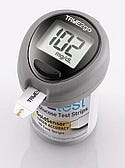World’s Smallest Glucose Meter Keeps Up with Users
May 10, 2009
Originally Published MPMN May 2009
ENGINEERING SOLUTIONS: MDEA
World’s Smallest Glucose Meter Keeps Up with Users
|
The True2go portable glucose meter features a simple twist-on-and-off test strip vial, autocalibrates each test strip, and requires a smaller blood sample. |
Grandpa sits down at the breakfast table with his little black case. He opens it and takes out his blood glucose meter, the test strips, something to prick his finger with, and a napkin to dab his fingertip when he’s done. The process is tolerable, routine, and takes about five minutes. That was then. Now, people with diabetes can use the True2go portable glucose meter to get test results within seconds. Moreover, the meter requires a smaller blood sample, the test strips are packaged in a vial that attaches to the meter, and an eject button allows the user to release a used strip without having to touch the bloody end.
Home Diagnostics Inc. (HDI; Fort Lauderdale, FL; www.hdidiabetes.com) had previously created a combined glucose meter and strip vial system; however the company decided to redesign the system because it was not covered by many insurance plans. This limitation made it difficult for people to purchase the device over the counter, according to Brent Modzelewski, director of engineering, research, and development. “The True2go is a removable, reusable meter that is covered under insurance with most other glucose meters,” he says. Focusing its internal design team on making the meter more intuitive, the company turned to several suppliers to help integrate the necessary technology to make the device smarter as well.
HDI worked with Texas Instruments (TI; Dallas; www.ti.com) to design a custom integrated circuit (IC) that essentially became a “glucose-meter-on-a-chip,” says Modzelewski. The IC was vital to reducing production costs and increasing reliability. Because the miniature chip features low power consumption, HDI was able to make the meter significantly smaller than any other meter on the market. And with the chip’s large capacity, the portable meter can store up to 99 blood glucose tests, which is on par with standard meters.
“An MSP430 microcontroller was the natural choice due to the platform’s ultralow power consumption and impressive array of onboard analog,” says Charles Hadsell, TI’s catalog microcontroller unit marketing director. TI also was able to incorporate additional features into the chip required by HDI for the meter without having to implement a more-costly application-specific IC.
The most-challenging objective of the project, however, was to accurately and precisely mate the True2go meter with its TrueTest strips at the lowest possible cost to the consumer, according to Modzelewski. By developing the meter and test strips simultaneously, HDI was able to design the product as a whole system. “Doing so allowed us to make huge strides in performance as well as embedded strip-coding information,” he says.
Mating the parts involved setting up the device to code the reactivity of the test strips so that the parts communicate and generate an accurate glucose reading. Previous generations of meters required users to enter a number or insert a code strip into the meter every time a new package of strips was to be used. HDI used the latest no-code technology so that the meter can autocalibrate itself with every test strip. “To create a no-code system, HDI chose to embed strip lot–specific information into the test strip during the manufacturing process,” Modzelewski says.
This process required the assistance of Integrated Engineering Technologies (IETek; Tacoma, WA; www.ietek.net). IETek helped HDI design and integrate the necessary mathematical algorithms into the meter and strips that allow them to communicate. “Each kind of strip has a different chemistry and tells the meter what kind of chemical is on it and what calibration to use,” explains IETek owner Ferhan Kayihan.
In addition to mating the parts electronically, HDI wanted to make attaching and removing the strip vial from the meter easy for the user to do while on the go. A supplier to HDI for many years, CSP Technologies (Amsterdam, NY; www.csptechnologies.com) created the meter’s removable vial. Featuring embedded desiccants to keep the test strips safe from moisture, the vial also includes a sensor that prevents strips from jamming, according to Billy Abrams, CSP’s vice president of business development.
Modzelewski’s team, meanwhile, designed the meter so that it could twist on and off the strip vial with only a quarter turn. “The solution is cost-effective and ingenious in its simplicity, while being intuitively obvious for the end-user,” he says.
Copyright ©2009 Medical Product Manufacturing News
You May Also Like



